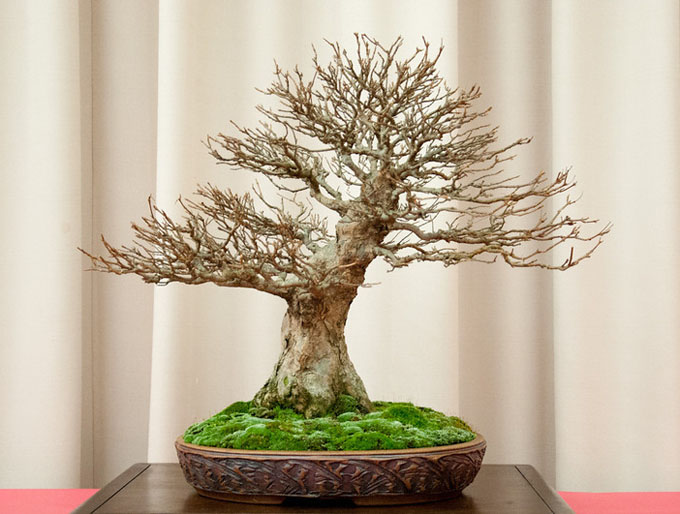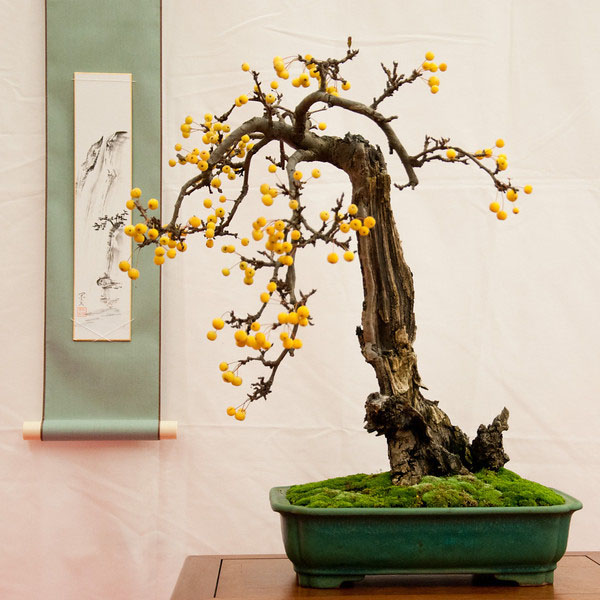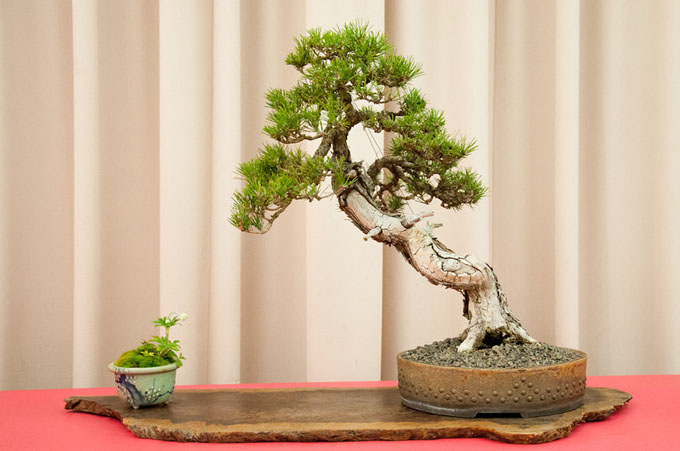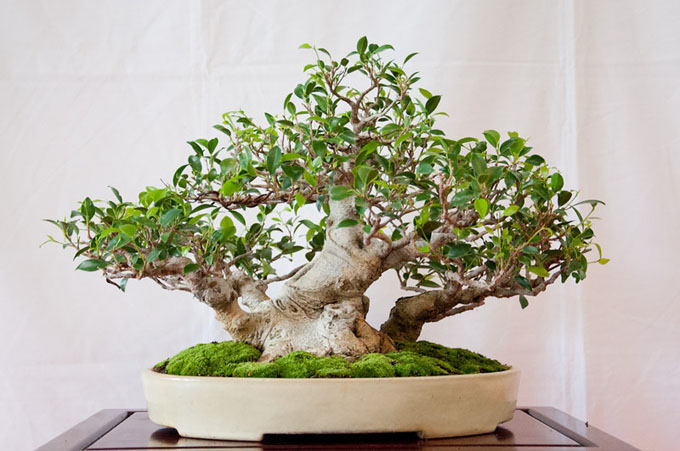 One things that has long distinguished Japanese bonsai from bonsai in the West is superior ramification. This noble Trident maple, sans leaves, aptly represents a trend; gradually Western bonsai artists are taking the time and trouble to develop fine branching. I don’t think we’re all the way there yet, but trees like this are a clear sign that we are on our way. A few other things that stand out about this tree are; how well balanced it is, how lush and bright the moss is, and the absolutely wonderful pot. Normally you see deciduous trees in glazed pots. Not so here, but no problem.
One things that has long distinguished Japanese bonsai from bonsai in the West is superior ramification. This noble Trident maple, sans leaves, aptly represents a trend; gradually Western bonsai artists are taking the time and trouble to develop fine branching. I don’t think we’re all the way there yet, but trees like this are a clear sign that we are on our way. A few other things that stand out about this tree are; how well balanced it is, how lush and bright the moss is, and the absolutely wonderful pot. Normally you see deciduous trees in glazed pots. Not so here, but no problem.
His trusty camera and excellent eye
The trees in this post are all from the Bay Area Bonsai Associates 30th Anniversary Exhibit. The photos are by Jonas Dupuich of Bonsai Tonight, who, along with his trusty camera and his excellent eye, seems to bounce between the U.S. West Coast and Japan on an almost daily basis.
 This aptly named Golden Hornet crabapple (Malus zumi) is a case of a tree that’s designed to show off its flowers and fruit (it’s the fruit now, but you can rest assured that the flowers had their day). Not to say that there aren’t some other interesting features, most notably the gnarly old base and the run-over-by-a-tractor look of the trunk, but still, those little yellow apples carry the day.
This aptly named Golden Hornet crabapple (Malus zumi) is a case of a tree that’s designed to show off its flowers and fruit (it’s the fruit now, but you can rest assured that the flowers had their day). Not to say that there aren’t some other interesting features, most notably the gnarly old base and the run-over-by-a-tractor look of the trunk, but still, those little yellow apples carry the day.
 A sweet, almost bunjin Japanese black pine and its little friend. Those cracks on the shari (the deadwood on the trunk) are a sign of late-stage deadwood decay; in other words, old age. I like the drum pot with its rough hand-built look. My only question is; if the pot were just a little smaller, would the power of the trunk and nebari be even more dramatic?
A sweet, almost bunjin Japanese black pine and its little friend. Those cracks on the shari (the deadwood on the trunk) are a sign of late-stage deadwood decay; in other words, old age. I like the drum pot with its rough hand-built look. My only question is; if the pot were just a little smaller, would the power of the trunk and nebari be even more dramatic?
 Nothing like a good ficus bonsai. Here in the far north, we can grow ficus indoors for seven or eight months, no problem. Unfortunately, they don’t develop very fast (to say the least) with only four or five months outdoors each year, and really only about two of those months warm enough to stimulate any growth. The Bay Area provides a much better climate for ficus, but still, it’s not exactly tropical, which brings me to my point; in order to develop such a stout trunk and strong branching, this tree probably spent its early years in more tropical climate. Or maybe in a greenhouse.
Nothing like a good ficus bonsai. Here in the far north, we can grow ficus indoors for seven or eight months, no problem. Unfortunately, they don’t develop very fast (to say the least) with only four or five months outdoors each year, and really only about two of those months warm enough to stimulate any growth. The Bay Area provides a much better climate for ficus, but still, it’s not exactly tropical, which brings me to my point; in order to develop such a stout trunk and strong branching, this tree probably spent its early years in more tropical climate. Or maybe in a greenhouse.
Wayne, I think the Black Pine is in a good sized pot. If it were smaller then yes, I think it would make the trunk/nebari appear more massive, but it is about as small as it can go in that potting orientation. I think any smaller and the tree would look overbalanced. Maybe with a more upright potting angle I wouldn’t feel that way, but I think the angle now is about right for the trunk.
Your comments about ramification are right on the money!
Thanks Zack for another insightful comment.
I was thinking more of the Japanese show-pot technique, where the pot is a little too small and the tree is put back into a more appropriate pot right after the show. The advantage is, as mentioned, dramatization of the trunk and nebari. Still, your observation about the planting angle is well taken.
Thanks Steve,
Is my check in the mail?